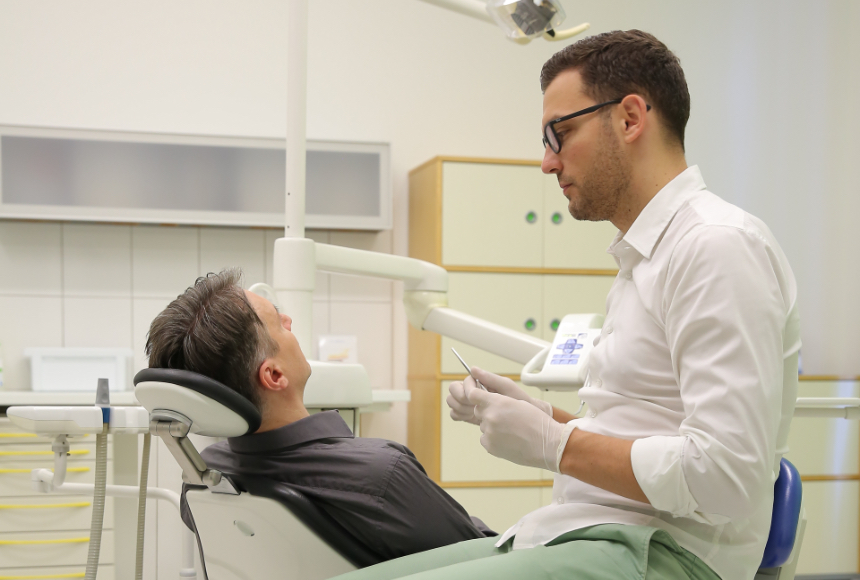In case a tooth is extensively damaged or crooked but other than that the root is good, there is no inflammation and therefore can be kept then the tooth is being covered by a dental root canal crown. A tooth crown protects the tooth and solves the functional and aesthetic problems. With crowns and bridges we can imitate the real teeth perfectly so that even experienced eyes might not see the difference between original and fake. Crowns and bridges are mainly made out of ceramic fused to metal or of full ceramic.
If natural teeth are used for a bridge then those are being prepared (grinded down) in order to be able to carry the dental bridge.
A crown can be fixed on an implant also if the tooth does not exist anymore or the damage is so extensive that it has to be removed and replaced. In this case we talk about an implant crown.
We talk about a dental bridge if one or more gaps are treated with a prosthetic solution instead of placing an implant. A bridge consists always of at least three parts and tides over the gap by being attached on the two neighbouring teeth that are the pillars or on two or more implants having the same function as a natural root. Then we talk about a dental implant bridge
The elements of a bridge are also crowns and almost all crowns and bridges are made of metal with ceramic lining or of full ceramic (Zircon ceramic).
WHAT ARE THE DIFFERENCES IN THE QUALITY OF DENTAL CROWNS?
There are big differences between dentist techniques and dental laboratory procedures, which can greatly affect the longevity and accuracy of dental crowns. These differences can be…
In dentist techniques:
- Tangent preparation (the upper surfaces of the tooth are completely abraded)
- Shoulder preparation (tooth is only ground off laterally during preparation)
At Evergreen Dental, only the shoulder preparation is used, as the situation allows, because this way
- More tooth substance can be saved
- The crown sits more stable on the tooth
In the dental laboratory:
- Production of the framework by conventional casting
- Manufacturing with the latest Laser Synther method
- CAD / CAM procedure
Evergreen Dental uses only the latest techniques, Laser Synther technology eliminates inaccuracies of conventional pouring, and CAD / CAM planning allows for accurate digital planning and computerized manufacturing (Zircon, for example). Depending on the situation, crowns are either cemented or screwed on implants.
As you can already see from these examples, there are serious differences that produce a very different result, although theoretically you get the same type of tooth crown, so you should always know in advance how the teeth are prepared and the crowns made.

WHICH TYPES OF DENTAL CROWNS DO EXIST?
The type of tooth crown is very important, it is determined depending on the situation or the patient request. The most common types of crowns and bridges are the following:
FULLY CASTED CROWN although this type of crown is often used in therapy planning and theory, it is rarely used in practice. Evergreen Dental does not offer this type of crown at all. It is a metal crown of non-precious metal. This is the cheapest type of full crown, but because of the optical defects and the compromise in wearing comfort, if at all, then only used in the molar area.
Porcelain fused to metal crown: these crowns have a metal frame and a ceramic lining on the surface. With the ceramic the anatomical effect is being created. These crowns are inexpensive and still they allow a very good stability and aesthetics. Both function and look are very good therefore it is the most chosen crown type. Much is depending on the ceramic master in the dental lab applying the ceramic lining as he/she will determine the final look and if the work is being done thoroughly the result can be a full anatomic tooth looking exactly like a natural tooth. Also the material used is of high importance therefore always make sure the best material is used for your dental work.
e.Max full ceramic crown: this metal-free crown type is being pressed of a ceramic block therefore it’s often called pressed-ceramic crown. E.Max crowns are very resistant and look just like natural teeth, are usually used in front region where the aesthetics has a major role.
Zirconia crown: just like full ceramic crowns Zirconia crowns are also completely metal-free, are extremely resistant and can withstand even the strongest chewing power are therefore often used in back region for the replacement of molars where the pressure is the highest. Also Zirconia is perfect for strong, durable, high-aesthetic bridges. It is being produced with the so called CAD/CAM method (computer-aided-design / computer-aided-manufacture) meaning that the crowns and bridges are being planned digitally and individually and also the production is steered by a computer. The teeth are individually being routed out of a Zirconia block then anatomically lined with ceramic.
CROWN ON PIN: root canal-treated teeth can also serve as a support for dental crowns. However, in a root canal treatment, the tooth interior, the vital pulp, is removed, resulting in loss of mass. This mass is filled up with a pin. This pin serves to further stabilize the crown and is mostly made either of metal or metal with fibreglass, in some cases of composite or ceramic.
TEMPRARY CROWN: is made of plastic for a transitional period and is therefore often called plastic crown. We distinguish between short-term temporaries and long-term temporaries. Short-term temporary restorations are usually done by the dentist for a maximum of one week in the dental office to protect the tooth stump, while long-term temporary restorations are made for a slightly longer period of time, up to 6 months, and made in the dental laboratory.
Long-term temporary crowns are usually made in case the bite needs adjustment before the final restoration. Often, an additional metal reinforcement is also incorporated. Possible causes are:
- Bruxism (overbite)
- Crooked teeth
- Under bites
While the patient wears the long-term temporary crowns, he gets used to the future anatomical conditions, because the bite is adjusted accordingly. This correction time usually takes between 2 and 6 months.
IMPLANT CROWN:
An implant crown is not fixed on the natural tooth root, but on an implant. The implant screw serves as the artificial root, in which, after the healing time of the set implant, a so-called abutment element is screwed, which serves as a link between the implant screw and the implant crown.
Implant crowns are either cemented or screwed, depending on the situation. Implant crowns are made of either metal-ceramic or zirconium.
Implants, like tooth roots, can also carry implant bridges. In this case, either one or two gaps are bridged by means of two implants or even used in a complete restoration as pillars, so for example. 6 implants usually carry a full bridge consisting of twelve teeth.
WHAT ARE THE STEPS TO THE NEW CROWN?
The creation of a new dental crown takes between 5 and 10 working days depending on the number and includes the following steps:
- Drawing up the treatment plan based on X-ray and physical check-up.
- Removal of tartar if needed.
- Preparation of the tooth and application of short-term temporary crown.
- Different probes in all the creation stages of the crown checking shape, fitting, color, etc.)
- Finalization of the dental crown either cemented or screwed depending on the anatomic situation.
HOW LONG DO DENTAL TOOTH CROWNS LAST?
A well-made high-quality dental crown, as made by Evergreen Dental’s dental laboratory, should last at least 20 years, but much depends on the patient; how the patient deals with the new teeth. A good oral hygiene and annual checks with professional teeth cleaning are the prerequisite of longevity.

WHAT ARE THE BENEFITS AND DISADVANTAGES OF CROWNS?
Advantages
- Fixed solution
- Durable
- Save the teeth
- Feel like real teeth
- Depending on function resistent (zircon in the molar region) or highly aesthetic (full ceramic in the front region)
- Can anatomically imitate the original tooth one to one, both in shape and in colour
- Seem very natural
Disadvantage
- The tooth substance must be reduced
- For bridges, healthy teeth may need to be ground off
- Hygiene is very important, bacterial attacks cause inflammation and sensitivity
HOW MUCH DOES A DENTAL CROWN COST?
The costs for dental crowns at Evergreen Dental are the following*:
- Porcelain fused to metal – £215,
- Zirconia crown – £302
- e.Max full porcelain crown – £302
- Temporary crown (short-term) – £17
- Temporary crown (long-term) – £65
- Temporary crown with metal reinforcement – £82
- Porcelain fused to metal crown on implant – £241
- Zirconia crown on implant – £327
Same with dental bridges, a fixed dental bridge of 3 units of porcelain fused to metal costs £645, Zirconia bridge costs £906.
*Evergreen Dental reserves the right of price changing.
HOW LONG IS THE WARRANTY ON CROWNS?
On dental crowns made of metal-ceramic, zirconium or e.Max all-ceramic we offer a guarantee of 5 years.
EVERGREEN DENTAL
YOUR SPECIALIST FOR HIGH QUALITY TOOTH CROWN
Evergreen Dental is your specialist in Budapest for long-lasting crowns. For all our crowns, only the most modern techniques and the best materials are used both in the preparation phase and in the production. Sufficient amount of probes in each stage of creation ensure perfect crowns fulfilling every expectation. Leave nothing to chance and an offer from our team of specialists.
